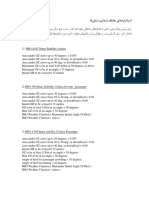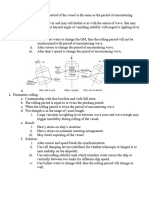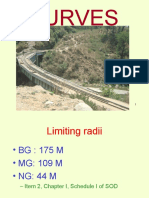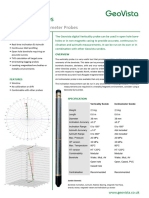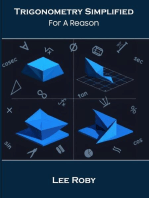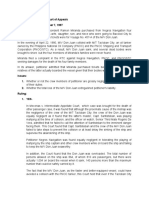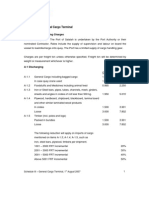Intact Stability For All Ships
Intact Stability For All Ships
Uploaded by
Saurabh Singh RawatCopyright:
Available Formats
Intact Stability For All Ships
Intact Stability For All Ships
Uploaded by
Saurabh Singh RawatOriginal Title
Copyright
Available Formats
Share this document
Did you find this document useful?
Is this content inappropriate?
Copyright:
Available Formats
Intact Stability For All Ships
Intact Stability For All Ships
Uploaded by
Saurabh Singh RawatCopyright:
Available Formats
INTACT STABILITY CRITERIA FOR ALL TYPES OF SHIPS
STABILITY CRITERIA FOR GRAIN STABILITY CRITERIA FOR SHIPS CARRYING TIMBER DECK GENERAL CRITERIA FOR OTHER SHIPS OIL TANKER OF 5000 DWT & ABOVE ADDITIONAL CRITERIA FOR PASSENGER SHIPS CONTAINER SHIPS FOR MORE THAN 100M IN LENGTH
CARGO
1. The angle of heel due to the shift of the grain is to be not greater than 1. The provisions given hereunder apply to all ships of 24 m in length 1.The area under the righting lever curve (GZ curve) shall not be less than 1.The area under the righting lever curve (GZ curve) shall not be less than 1.The area under the righting lever curve (GZ curve) shall not be less 1. The area under the righting lever curve (GZ curve) should not be less than 0.009/C metre
12 degrees or the angle at which the deck cargo is immersed, and over engaged in the carriage of timber deck cargoes. 0.055 metre-radians up to = 30°angle of heel and not less than 0.09 metre 0.055 metre-radians up to = 30°angle of heel and not less than 0.09 metre than 0.055 metre-radians up to = 30°angle of heel and not less than 0.09 radians up to ϕ = 30° angle of heel, and not less than 0.016/C metre-radians up to = 40° or
whichever is the lesser. radians up to = 40° or the angle of down-flooding if this angle is less than radians up to = 40° or the angle of down-flooding if this angle is less than metre-radians up to = 40° or the angle of down-flooding if this angle is the angle of flooding ϕf (as defined in part A, 2.2) if this angle is less than 40°.
40°. Additionally, the area under the righting lever curve (GZ curve) 40°. Additionally, the area under the righting lever curve (GZ curve) less than 40°. Additionally, the area under the righting lever curve (GZ
between the angles of heel of 30° and 40° or between 30° and , if this between the angles of heel of 30° and 40° or between 30° and , if this curve) between the angles of heel of 30° and 40° or between 30° and , if
angle is less than 40°, shall not be less than 0.03 metre-radians. angle is less than 40°, shall not be less than 0.03 metre-radians. this angle is less than 40°, shall not be less than 0.03 metre-radians.
2. The net or residual area between the heeling arm curve and the righting 2. The area under the righting lever curve (GZ curve) shall not be 2.The righting lever GZ shall be at least 0.2 m at an angle of heel equal 2.The righting lever GZ shall be at least 0.2 m at an angle of heel equal 2.The righting lever GZ shall be at least 0.2 m at an angle of heel equal 2. Additionally, the area under the righting lever curve (GZ curve) between the angles of
arm curve up to the angle of heel of maximum difference between the less than 0.08 metre-radians up to = 40° or the angle of flooding to or greater than 30°. to or greater than 30°. to or greater than 30°. heel of 30° and 40° or between 30° and , if this angle is less than 40°, should not be less
ordinates of two curves, or 40 degrees or the angle of flooding, whichever if this angle is less than 40°. than 0.006/C metre-radians.
is least, is in all conditions of loading to be not less than 0.075 m.radian.
3.the initial metacentric height , after correction for free surface effects of 3.The maximum value of the righting lever (GZ) shall be at least 0.25 m. 3.The maximum righting lever shall occur at an angle of heel not less than 3.The maximum righting lever shall occur at an angle of heel not less than 3.The maximum righting lever shall occur at an angle of heel not less 3. The righting lever GZ should be at least 0.033/C m at an angle of heel equal or greater
liquids in tanks , is to be not less than 0.30 m. 25°. If this is not practicable, alternative criteria, based on an equivalent 25°. If this is not practicable, alternative criteria, based on an equivalent than 25°. If this is not practicable, alternative criteria, based on an than 30°.
level of safety may be applied subject to the approval of the Administration. level of safety may be applied subject to the approval of the Administration. equivalent level of safety may be applied subject to the approval of the
Administration.
4.After loading, the master shall ensure that the ship is upright before 4. At all times during a voyage, the metacentric height GM0 s hall not 4.The initial metacentric height GM0 shall not be less than 0.15 m. 4.The initial metacentric height GM0 shall not be less than 0.15 m. 4.The initial metacentric height GM0 shall not be less than 0.15 m. 4. In the criteria the form factor C should be calculated using the formula below
proceeding to sea be less than 0.1 m, taking into account the absorption of water by
the deck cargo and/or ice accretion on the exposed surfaces
5.demonstrate the ability of the ship at all stages of any voyage to comply 5. When determining the ability of the ship to withstand the combined 5. In addition, the angle of heel on account of crowding of passengers to one sid
tability criteria required by this section.
with the s effects of beam wind and rolling according to Heeling Weather shall not exceed 10°. A min
Criterion (IS Code Shap 2.3), the 16° Limiting angle of heel under kg shall be assumed for each passenger except that this value may be increased
action of steady wind shall be complied with, but the additional approval of the Administration. In addition, the mass and distribution of the lugga
criterion of 80% of the angle of deck edge immersion may be ignored. by the Administration.
The height of the centre of gravity for passengers shall be assumed equal to
1 m above deck level for passengers standing upright. Account may be taken, if
and 2. 0.3 m above the s
6. the cargo extends longitudinally between superstructures 6. Passengers and luggage shall be considered to be in the spaces 5 The total area under the righting lever curve (GZ curve) up to the angle of flooding ϕf
normally at their disposal, when assessing compliance with the criteria should not be less than 0.029/C metre-radians.
given in 2.2.1 to 2.2.4.
In addition, the angle of heel on account of turning shall not exceed 10° 6. The maximum righting lever GZ should be at least 0.042/C m.
when calculated using the following formula:
‘=0.2 x (V20/L WL ) x Δ x (KG-(d/2)) The above criteria may also be applied to other cargo ships in this length range with
considerable flare or large water plane areas.
where:
• M R = heeling moment (kNm)
• v 0 =
service speed (m/s)
• L WL = length of ship at waterline (m)
• Δ = displacement (t)
• d = mean draught (m)
• KG = height of centre of gravity above baseline (m).
As Per Intact Stability Code PART-A Chapter 3.4 / Resolution MSC 23 (59) As Per Intact Stability Code PART-A Chapter 3.3 As Per Intact Stability Code PART-A Chapter 2.2 As Per Intact Stability Code PART-A Chapter 3.2 & MARPOL ANNEX 1 Re As Per Intact Stability Code PART-B Chapter 2.3
MaKK
You might also like
- Standard Operating Procedures (Sop) For Repair of Vessels:: Planned Repairs100% (2)Standard Operating Procedures (Sop) For Repair of Vessels:: Planned Repairs8 pages
- OCIMF Environment Forces Calculator On VLCC100% (1)OCIMF Environment Forces Calculator On VLCC9 pages
- Assignment 2 Intact Stabilty Nurul AiyaniNo ratings yetAssignment 2 Intact Stabilty Nurul Aiyani4 pages
- 1 Nerul Tact Stability Criteria (Is Code 2008) : Area Under The GZ CurveNo ratings yet1 Nerul Tact Stability Criteria (Is Code 2008) : Area Under The GZ Curve1 page
- Ship Stability - Curves of Statical Stability Load Line Requirements For Minimum Stability ConditionsNo ratings yetShip Stability - Curves of Statical Stability Load Line Requirements For Minimum Stability Conditions3 pages
- Fenner-Dunlop Conveyor Problems & Solutions100% (1)Fenner-Dunlop Conveyor Problems & Solutions18 pages
- Transition Curves in Road Design (Similar To Pun Miah)No ratings yetTransition Curves in Road Design (Similar To Pun Miah)31 pages
- Applications of Friction in Machines: EL201 - Genap 2018/2019No ratings yetApplications of Friction in Machines: EL201 - Genap 2018/201918 pages
- Concrete Delivery Requirements Safety Data SheetNo ratings yetConcrete Delivery Requirements Safety Data Sheet6 pages
- Renewable Energy Laboratory: Ing Jimmy CordovaNo ratings yetRenewable Energy Laboratory: Ing Jimmy Cordova4 pages
- Comparative Analysis of Is 807:2006 With Is 807:2006 Amendment No.1No ratings yetComparative Analysis of Is 807:2006 With Is 807:2006 Amendment No.14 pages
- 3 Subdivision and Stability 1 Passenger Vessels: 1 DefinitionsNo ratings yet3 Subdivision and Stability 1 Passenger Vessels: 1 Definitions2 pages
- Recommendations For Machine Design: Siegling TransilonNo ratings yetRecommendations For Machine Design: Siegling Transilon20 pages
- Curves - Concepts and Design Part-2 24 25-02-2015No ratings yetCurves - Concepts and Design Part-2 24 25-02-201582 pages
- Recommendations For The Installation Planning of Belt WeighersNo ratings yetRecommendations For The Installation Planning of Belt Weighers4 pages
- Morgan - Carbon Brushes Technical Handbook PDFNo ratings yetMorgan - Carbon Brushes Technical Handbook PDF20 pages
- Fig. 3.2 Hydrostatic Curve Using Tribon SoftwareNo ratings yetFig. 3.2 Hydrostatic Curve Using Tribon Software3 pages
- Regulation 28 - Subdivision and Damage Stability 1. Every Oil Tanker Delivered After 31 December 1979, As Defined in RegulationNo ratings yetRegulation 28 - Subdivision and Damage Stability 1. Every Oil Tanker Delivered After 31 December 1979, As Defined in Regulation3 pages
- Module 5: Design and Investigation of Steel Beams Lesson OutcomesNo ratings yetModule 5: Design and Investigation of Steel Beams Lesson Outcomes8 pages
- Twine or Net Wrapping - Fast, Reliable, Economic!: RP 505 - RP 535No ratings yetTwine or Net Wrapping - Fast, Reliable, Economic!: RP 505 - RP 5354 pages
- Cylindrical Compression Helix Springs For Suspension SystemsFrom EverandCylindrical Compression Helix Springs For Suspension SystemsNo ratings yet
- Navigation & Voyage Planning Companions: Navigation, Nautical Calculation & Passage Planning CompanionsFrom EverandNavigation & Voyage Planning Companions: Navigation, Nautical Calculation & Passage Planning CompanionsNo ratings yet
- Imo Performance Standards For S - VDR Imo Performance Standards For Shipborne Simplifiedvoyage Data Recorders (S-VDRS)No ratings yetImo Performance Standards For S - VDR Imo Performance Standards For Shipborne Simplifiedvoyage Data Recorders (S-VDRS)5 pages
- International Convention of Maritime SAR, 1979 PDFNo ratings yetInternational Convention of Maritime SAR, 1979 PDF48 pages
- Ship Handling and Manuevering: SEA 305 BNo ratings yetShip Handling and Manuevering: SEA 305 B32 pages
- A. Requirements FOR "Captain IN Fishing Vessels" Fishing VesselNo ratings yetA. Requirements FOR "Captain IN Fishing Vessels" Fishing Vessel2 pages
- 1322007-STAB02-R2 (Prel. Stability Calculation For 2 STS Cranes On MV Vestvind)No ratings yet1322007-STAB02-R2 (Prel. Stability Calculation For 2 STS Cranes On MV Vestvind)23 pages
- Insect Physiology and Biochemistry 3rd Edition Wei Zhi All Chapters Instant Download100% (5)Insect Physiology and Biochemistry 3rd Edition Wei Zhi All Chapters Instant Download34 pages
- M.V. African Hawk: Verbal Orders by Master On Address SystemNo ratings yetM.V. African Hawk: Verbal Orders by Master On Address System9 pages

















